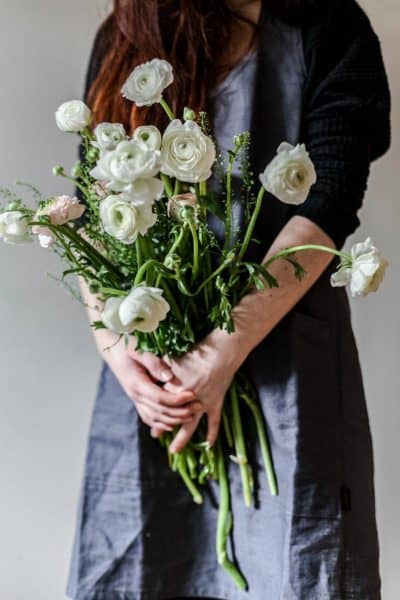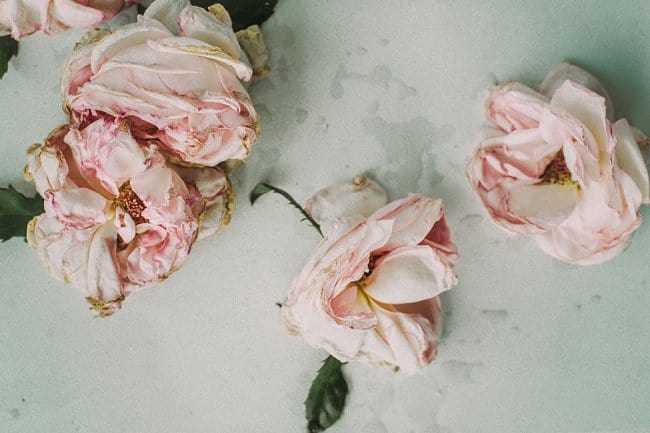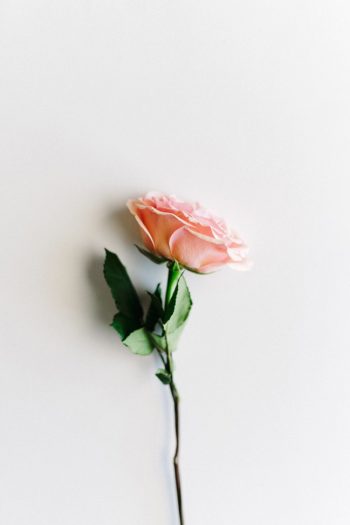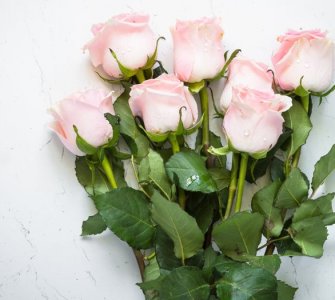In this post I’m sharing my best tips on how to care for roses indoors. You’ll discover along with me what roses need to thrive indoors, how long you can expect an indoor rose to last, and how to spot and prevent rose pests and diseases!
Growing up we had a tiny garden but one small strip of earth down one side of the ‘lawn’ / postage stamp was filled with rose bushes, and I remember every summer being so happy to see them bloom.
I don’t have even a postage stamp of lawn now, or even a flower border, now that I’m practically a grown up 😉 But I believe that’s not a reason not to have that beautiful scent and gorgeous blooms filling my home (ok, well, my office at least).
So, I’m sharing how to care for roses indoors right now. Hopefully this will save you the hours of research it took me to discover all this, and help you to grow and cultivate your own beautiful roses indoors! (even if, like me, you usually kill most plants).
Although I’m not an expert, this post is the culmination of literally days of research on how to care for roses indoors, and I’ll update you on my own indoor roses very soon – keep an eye on the personal posts right here!
Table of Contents
Is It Easy To Care For Roses Indoors?
Even though a rose is the queen of flowers, with its delicate beauty- like all Queens, it is not easy to maintain!
It is finicky and sometimes won’t last long even in the best of circumstances. A rose generally needs direct sunlight exposure, a loamy soil type and soil pH that is somewhere between slightly acidic and neutral.
Don’t worry, I’ll simplify what this means throughout the post to ensure you can grow roses indoors that bloom beautiful, and that last! The good news is that with a bit of know-how, almost all species of rose can grow indoors all year round!
What does a Rose Need To Grow Indoors?
Light
Roses lap up sunlight, so you’re going to need to place your roses in direct view of the window, so my office isn’t sadly going to be the best space for them, despite having a window and a door to allow in the daylight! The sunlight is blocked from coming in as we have a giant wall outside. So while the daylight gets in, it’s not a bright and sunny room.
Consider where you’re going to put the rose first – do you have a sunny spot, corner, window ledge, seat, or other sunny area?
Where Shall I Put A Rose Plant Indoors?
Choose an area that receives most direct sunlight possible (6 hours minimum). The daytime temperature should not go over 24℃ (75℉) nor under 5℃ (40℉) at night.
Your apartment or house conditions directly influence whether you are about to grow a full-size rose bush in your sunny all-windows room, or if you are going to grow a modest potted rose plant at your windowsill. Choose your rose sort accordingly to set yourself up for success.
If you are growing miniature roses, make sure that, if you can, put them outside for the summer months of the year and bring back indoors for the rest of the year. Even a sunny window ledge or doorstep works! I have no garden but my rose plants will be going just outside my office door this summer, fingers crossed the wall won’t totally block out all sunlight!
Rotate your miniature rose plant every few weeks so that all areas of the plant are receiving similar amounts of light and growing symmetrically. Beginner gardeners often don’t know about this, but it is a trait of many plants who just can’t get enough of sunlight.
How Often Should I Water My Indoor Rose Plant?
Once the rose is planted, it should thoroughly be watered so that the soil stays damp, but not soggy. So how often you water your indoor rose plant really depends on the temperature and humidity in your indoor space.
When the potting mix which the rose plant is in feels dry-ish 2.5 cm (1 inch) below the surface, water thoroughly – the soil mix should never dry out completely, or be oversaturated.
It is advised generally not to water between 9am and 6pm, especially during the summer months, as this is typically the hottest part of the day and evaporation is more intense during these hours.
Try and keep water off the leaves, as roses don’t like their leaves touched! (I did say roses were like temperamental Queens)! Wet leaves can lead to fungi and other plant diseases. It is advisable that every week or so, you use a soft cotton cloth and very gently clean the leaves to remove dust.
The great thing about growing roses indoors in pots is that you get to control the amount of water your rose receives – no more downpours flooding the rose soil or droughts like you might otherwise experience growing roses outside.
The pot should be able to drain well – it has to be heavy enough to hold moisture that you provide but also minimise the likelihood of root rot occurring, especially in a young plant.
If the pot drains a bit too fast, the mix will dry out before the roots can even take any moisture.
What Size Pot Should I Get For My Rose Plant?
The pot or the container which will serve the rose must be picked depending on the type of rose you choose.
If you are growing a rose bush, choose a relatively big and tall pot, no less than 38 cm (15 inches). Roses are a deep-rooted variety of plant so it is good the container is as tall as it can be. If you are choosing a climbing rose choose a tub style long pot as opposed to a vertical one, to give that rose more room to grow sideways as well as up!
Choose clay pots over plastic pots because clay transfers heat from the sun into the soil much more slower – if it really has to be plastic, at least bu light-coloured ones – it won’t heat up as fast.
Remember to check your pot has drainage holes. Without them, your rose’s soil will get waterlogged and the rose will be unable to take nutrients from the root.
If there are no drainage holes in your pot for your indoor rose, make them using a pair of scissors!
You can also place a layer of gravel about 2.5 cm (1 inch) deep in the bottom of the pot which will help the soil drain more effectively, while the rose can retain nutrients better.
The Best Type Of Soil For Indoor Roses
The soil you’re using to take care of your indoor roses should be rich in nutrients and slightly permeable, as mentioned up there, keep in mind it shouldn’t be too heavy in organic material, as that can also lead to root rot. Such soil easily becomes soggy and traps too much moisture.
Roses like their soil loamy – loam being a type of soil composed mostly of sand, silt and a smaller amount of clay.
The recipe that works the best for making your own is:
- 2 parts of lawn soil
- 2 parts of well-composted animal waste
- 1 part of mould
- 1 part of sand
The slightly acidic to neutral scale I mentioned briefly in the introduction is nothing more than roses just preferring a near-neutral pH of 5.5–7.0.
A pH of 6.5 is considered ideal, and that is the slightly acidic to neutral number that works the best in a soil for a rose. You can get little pH testing strips online from Amazon easily and cheaply. They make you feel like a real gardener 😉 Roses actually prefer an acidic environment, and you can help get this by adding coffee grounds to the soil. That’s a big win for me, because I drink a ton of coffee! So I get to take care of roses indoors AND recycle some kitchen waste, yay 🙂
Note – never apply coffee grounds right next to the plant. Sprinkle them over the top and gently fork or rake them over into the soil, as they can actually burn your poor rose plant!
If your soil is too acidic, you can apply finely ground limestone to help neutralise it.
For a sweet/alkaline soil, treat it with ground sulphur. All of these products can be found at your local garden centre, or you can order online.
Using Fertilizer To Help Care For Indoor Roses
Roses can eat a lot, and if they are placed in a pot, they can quickly suck up all the nutrients from the soil that are available. As such, potted roses require more intense and more frequent feeding than garden varieties.
During fall and winter, fertilize once a month with a balanced houseplant fertilizer (such as 20-20-20). If you find a fertilizer marketed as being especially for roses, those are also good, as they usually have additional ingredients that help with prevention of pests and plant diseases.
During spring and summer when your rose plant is actively growing, fertilize every two weeks.
One more thing you can do during spring is to add MgSO4 (Epsom salts) around the base which ensures the rose also gets its dose of magnesium.
Over-fertilizing is also bad, for growing roses indoors, and will cause your rose to die, so make sure to follow directions well. Fertilizer must stay out of contact with the leaves at all times.
To keep your plant healthy,
- feed when the bush first leafs-out,
- feed after each heavy bloom
- stop feeding about 6-8 weeks before the first expected frost.
Growing Roses Organically Indoors
Personally, I’m going renegade with my indoor rose-growing and I’m using just manure to grow them. I don’t know how will this will work, I will keep you updated! but unless I can find some pure organic and natural fertiliser (let’s face it, that’s probably just manure anyway)!?! I don’t plan on using it.
We are a mostly chemical-free and organic family where possible (no halo here)! so I’d rather garden organically if I can.
I’m not sure how that’s going to pan out with these temperamental roses – let’s see!
Top Tips To Care For Roses Indoors
Water regularly
Roses in growth are thirsty, and in pots they are prone to drying out quickly. So, stick your finger in the soil every day and check for dryness.
Remove wilted blooms
Remember to remove flower heads as soon as they are wilted. This is for aesthetic reasons, as well as to encourage a long blooming season. Use sharp pruners and cut at a 45-degree angle. Tearing the flower off will risk hurting you and damaging the rose stems, which can quickly lead to disease.
Prune
Pruning is the act of removing dead branches or entwined branches. A young rose won’t need pruning, but as the time goes, prune it in fall, after the rose flowers.
Pruning should be best performed yearly and, just as removing wilted blooms, it stands to assure vigorous new growth and overall bettering of health of the rose plant. Pruning shears should be used to cut the stem at a 45-degree angle. Cut just above where the branch joins the main stem.
Keep up the sunshine!
Allow for plenty of light to get to your indoor rose. Especially if you are growing miniature roses, a minimum of 6 hours of direct sunlight is imperative.
Repotting Indoor Roses
Did you know, that cared for well, your indoor rose can last for years!? They will need to be repotted every two to three years (unless your rose is a miniature). This is due to roses love of taking nutrients from the soil. Even if you continuously fertilise the soil, you’ll need to start fresh every few years, or even more, to ensure that your rose has a continued supply of nutrients.
Use fresh potting soil every time you repot the rose.
Why Is My Indoor Rose Dying?
Freezing temperatures
Plants in pots do, in fact, get much colder than plants in the ground. Placing your rose plant in the sunniest spot in the house will help. Ensure this area is draught-free, and this will go a long way in your indoor rose care.
Pests and diseases
Don’t think you’re getting off the hook with critters just because your rose is potted and indoors. In the eyes of any bug, it is still as worthy of a prize!
The most common critter is the aphid, and aphids usually can be found on the buds and leaves where they will suck out rose juices and make the infected parts of the rose rot. If you spot them – just spray them down, off of the plant. You can also softly scrape them off with a tool. Preferably do this in the morning, so that the potentially wetted leaves have time to recover.
Indoor roses are also susceptible to fungal diseases such as powdery mildew and black spot. To prevent, make sure roses have good fresh air circulation. To cure already afflicted roses, look for a fungicide.
Black spots
Black spots are usually caused by damp conditions. Make sure to cut off affected leaves and treat foliage with a fungicide specifically made for blackspot. Make sure good air ventilation exists around the perimeter of your rose plant.
You might also want to look into choosing a rose hybrid that is more resistant to diseases if you find yourself having a general problem with the dampness of your living space.
Yellow leaves dropping off
An ailment of many reasons – lack of sunlight, dry soil and dry air can all cause yellowing and fallout of rose leaves. Resume good care – try moving the pot to where more direct sunlight is accessible, check if the soil is dry and water accordingly, making sure of the water passage and use air humidifiers if your living space calls for it due to dry air.
How Long does an Indoor Rose Last?
There is a rose tree at Hildesheim Cathedral, in Germany, that’s said to be over 1000 years old. It is believed to be the oldest wild rose tree in the world, standing at 15 metres tall, in the church courtyard.
Yours probably won’t live to see a millenia, but there are many people who can attest to their grandmother planting a prized rose bush in the garden in the 50’s and 60’s and through the right mixture of love, care and conditions they have thrived for decades.
The longevity of a rose depends on you to recognise the conditions of your apartment, how adaptable they will be (for example, can you match the lack of direct sunlight with artificial lightning, or can you purify the water if it is too rich on limestone – and you city girls know, it often is)!
It also depends on you choosing the right rose variety for your conditions; a variety that will thrive alongside you.
For observant beginners who devote their time to their rose plant, it is easy to anticipate the rose growing for years, provided it gets the necessary care, both the daily (watering), weekly (fertilizing) and the yearly (pruning).
Final Thoughts On Growing Roses Indoors
I hope that this post on what I’m learning about how to care for roses indoors is useful, and has managed to give you a good overview of what you need to know in order to take care of roses indoors.
With the hectic lives that we lead, a rose might seem to many people as a challenge, having observed many a store-bought rose fade and die rather fast.
However, a little care and a little knowledge will go a long way with having a blossoming and long lasting rose plant to talk to your friends about, that brightens up a corner of your room or balcony whenever it blooms. I’ll update you on my indoor roses very soon!





